Written on August 11, 2014
By Tony
in Uncategorized
First, let me say, none of these guns are mine, I don’t know the sellers, and I’m not making any money on them. I’m posting them here because they’re neat, and if I had unlimited resources, I’d buy them myself. 4 of the 5 we’re looking at today are less than $200.
First, the Savage model 23AA: 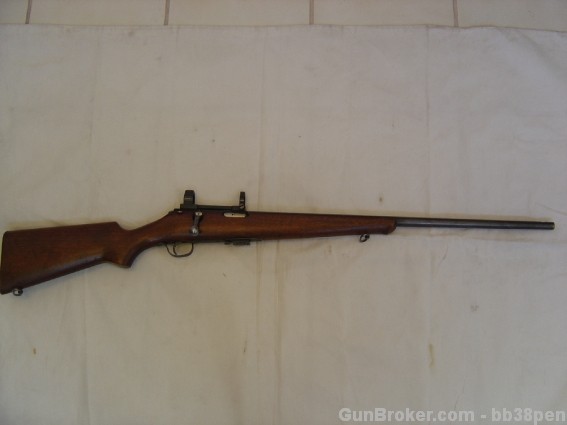
The rifle is pretty neat. It’s an older gun, and being .22 caliber, should be cheap to shoot (when you can find ammo) I also imagine that with the addition of a scope, it would be a great small game gun. Not bad for $160.
Next up: Another Savage.

This one is a Savage model 220. The 220 is mechanically very similar to the Savage 219, and the barrels are often interchangeable. This one is in 12 gauge, but finding a .22 hornet or 30-30 barrel would make it a very versatile little gun. And at $150, a real bargain compared to others on the market
The next one is a cute CVA single shot:
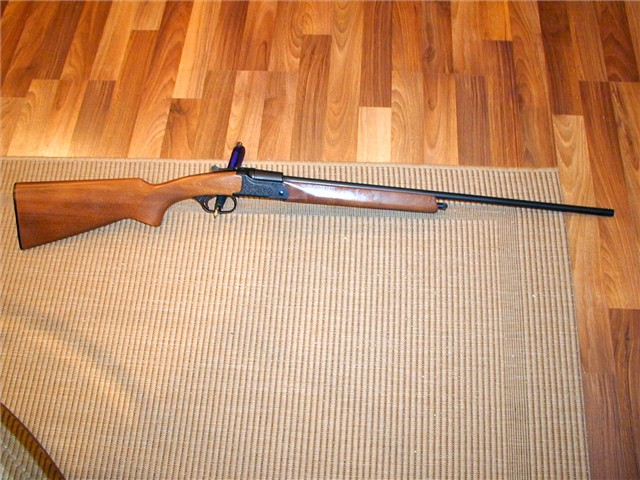
Like the Savage 220, it’s an internal hammer single shot, but the CVA model is a .410 bore. I believe these were made in Italy for CVA. I’ve shot one like this, an they’re very sturdy and good shooting guns. For $125, the price is as solid as the gun is!
The Cheapest gun today is the Butler derringer:

The little .22 single shot was likely made in the 70’s. I’ve owned several of them, and while they aren’t much for accuracy, there’s just something satisfying about shooting such a little gun, and being a .22, won’t break the bank when you do shoot it. The $85 price tag makes it’s novelty affordable.
My favorite, The Ballard Marlin:

In .32 long, the Marlin Ballard rifle is a great example of an old gun in an obsolete caliber. You guys know how I feel about .32’s. Since the firing pins could be reversed on a lot of these old ballard rifles, it’s quite possible that you could shoot this one as well. Since the .32 long RF shares cartridge dimension with the .32 Long Colt, swap the FP and getting some .32 LC ammo, and you’d be in business. Not cheap at $800, still a good price for the rifle.
Written on January 23, 2014
By Tony
in Handguns, NFA, Repeaters, Rifles, Semi Autos, Suppressors
I haven’t been able to do much shooting the last few weeks due to inclement weather, and various obligations (like paying the bills…) so I took a few minutes tonight to snap a few pics of some more of my suppressor hosts.
I’ve posted about most of these before, but I figured having some better photos and talking about why I like them would be better than not doing anything at all.
I originally built this ruger charger type pistol to test barrels and such for the long awaited SBR build that I completed recently. Once I was done with the testing, I added a few parts, and built this little gun. It’s quite accurate for such a short barrel, mostly due to the Kidd barrel, but it’s also a reasonable suppressor host. I say reasonable instead of great, because the Kidd barrel is just a bit too long to keep the cheap bulk ammo subsonic, so it’s louder than it would be if the barrel was an inch shorter.

This Contender G2 hasn’t really been talked about a lot yet, but it’s really a great host. Being a single shot, there’s no action noise aside from the hammer falling, and no ejection port noise either. The 16.25″ barrel requires subsonic ammo, like any other .22 rifle, to stay quiet, but it’s very accurate, and I’ve used it to shoot pests out at the old family homestead without annoying the neighbors.

The Walnut stocked Ruger 10/22 started life as a standard pre-warning gun. I still have all of the original parts I took off (barrel and trigger assembly) but I wanted something I could shoot with the suppressor and open sights, so I built the gun using the 21″ custom made SS barrel, and put a polymer trigger group on the rifle because it was already built with the auto bolt release, extended mag release and 2# trigger. I like the rifle a lot, but haven’t had a lot of opportunity to shoot it, as I’ve been working with other guns since I built it.

I’ve talked about this flamed out bump-fire .22 rifle before on the blog, but I don’t think I ever got a picture with the can attached. The Tac-Sol barrel of course is amazing, and pretty central to the build.

Written on January 21, 2014
By Tony
in NFA, Repeaters, Rifles, Single shot, Suppressors
A few weeks before Christmas, I took Kevin (my occasional camera man) to the range, and we did some shooting.
There was no particular theme to the evening shooting, but we got a little video of a few of the suppressor hosts in action. In particular, the Mauser 105 that I’ve talked about repeatedly, and the TC contender rifle.
As always, both guns were exceptionally quiet, and very nice hosts. Almost all the shooting was with CCI standard ammo, but the smith 422 shooting was with old stash CCI blazer. Here’s the video for your enjoyment:
Written on January 4, 2014
By Tony
in NFA, SBR's, Suppressors
After getting my Form 1 back to build this Ruger 10/22 SBR, I didn’t waste much time. I engraved the receiver myself using an old set of gravers. It’s ugly, but readable and conforms to required spec’s.
The barrel is 3.5″ to keep even hot bulk pack ammo and CCI mini-mags subsonic, the sight is a ‘Docter’ optic micro red dot, the stock is a custom built bumpfire stock and the trigger assembly is a Kidd 2-stage unit.


Video:
Update:
I’ve made some of the last changes to the configuration, and wanted to answer a few questions. First off, I’ve added a Vertical fore-grip and extended the thumb stud. This is what the updated rifle looks like:


And I wanted to explain some of the modifications to the stock.
When I added the choate folding portion to the stock, I machined away the fixed stock to fit the folding mechanism and butt-stock section. I also cut down the front end of the stock. Here’s a comparison next to a standard AA stock:
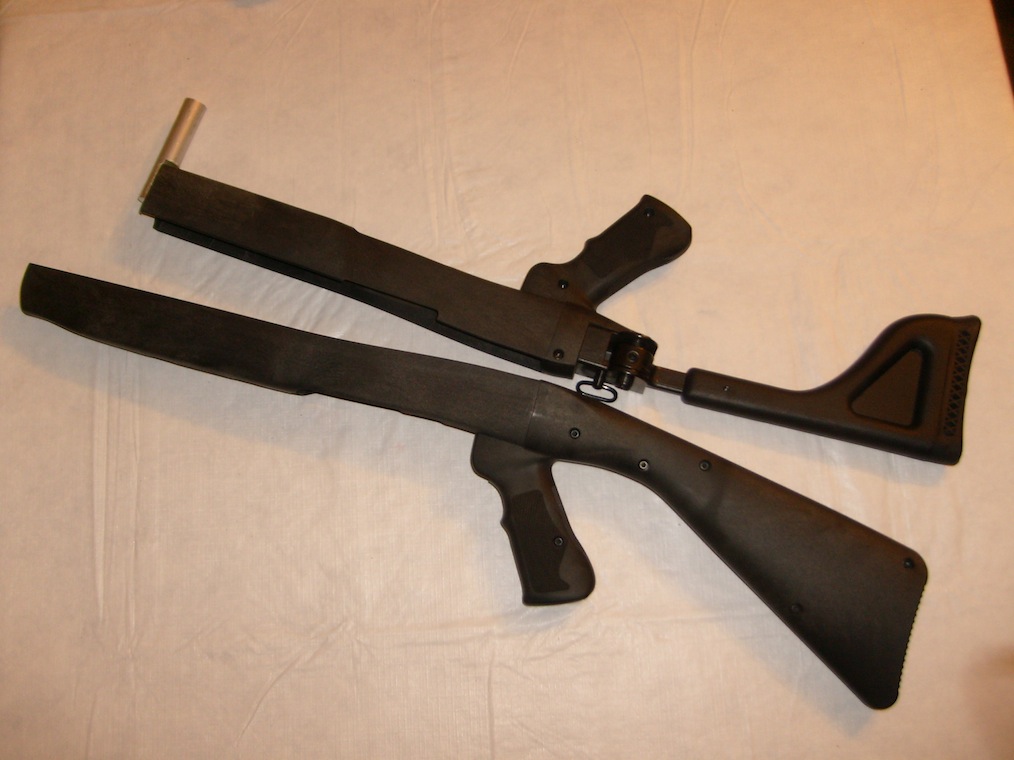
As you can see the choate folding portion is a good fit, and allows the overall length to be much shorter.
The LMA mechanism is what allows the magic to happen, it’s a series of linear bearings and precision ground rods intended to reduce friction. The photos below show the LMA in the rearward and forward position. The block that is moved in the photos actually remains stationary in the stock, and allows the guns action to smoothly slide forward and back.
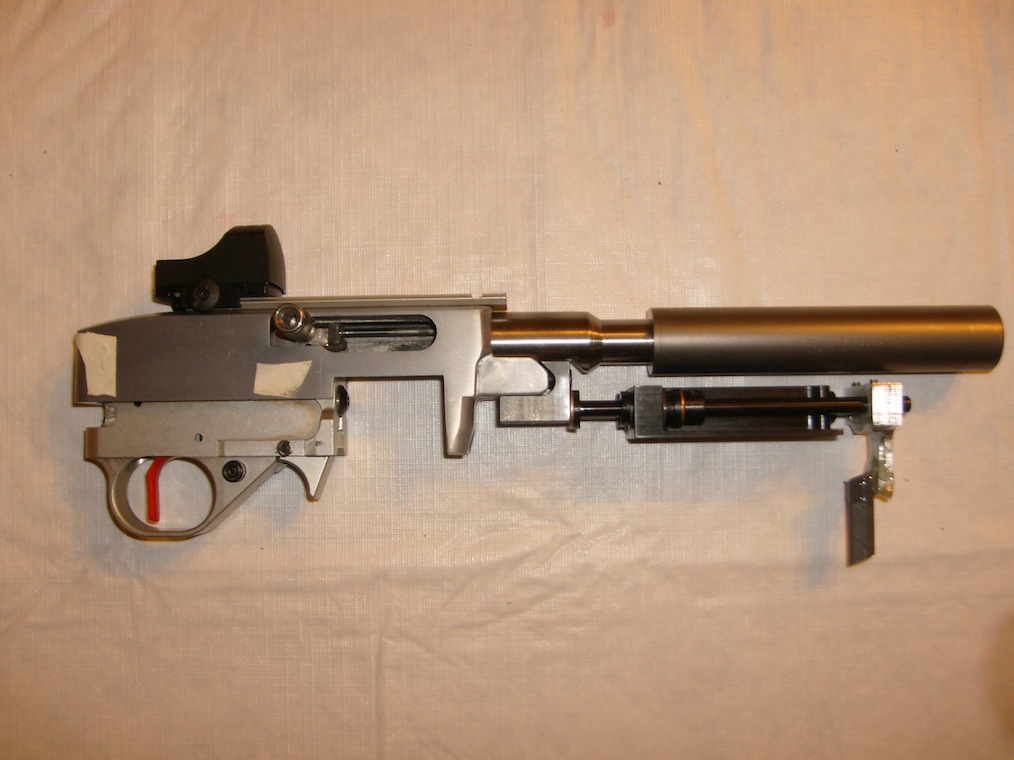
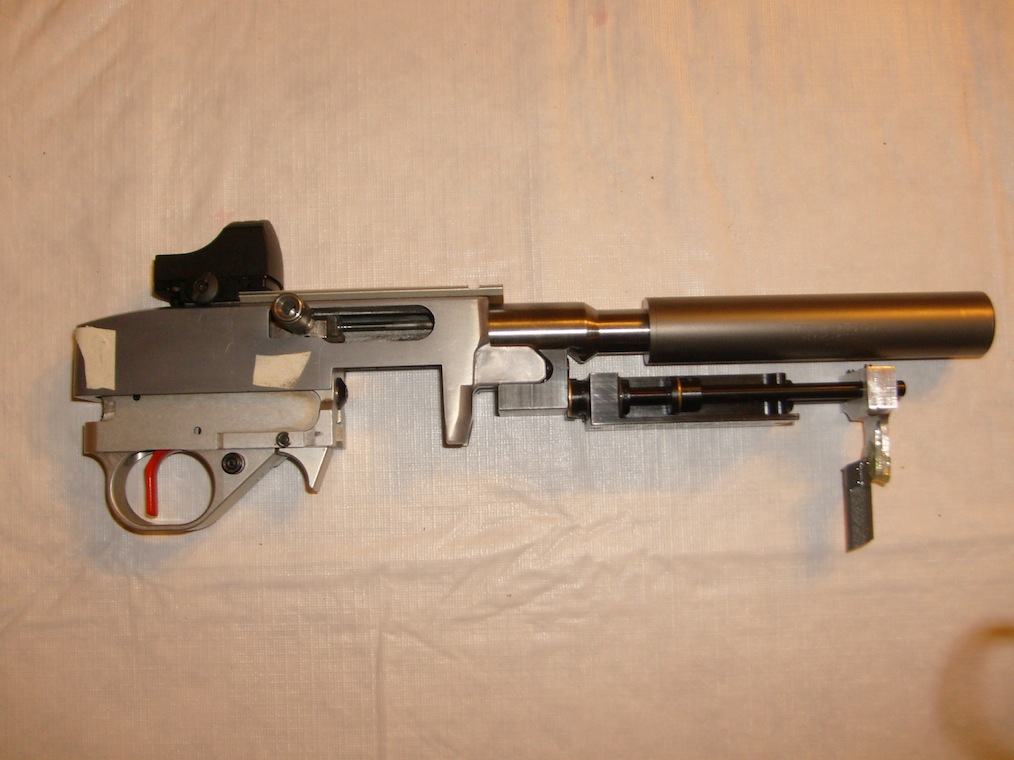
I hope that helps to answer some questions!
Written on December 31, 2013
By Tony
in Handguns, Revolvers
The first S&W model 30 wasn’t actually a J-frame. It was an ‘improved’ I frame. The J-frame didn’t start until the 30-1. The improvement that make the ‘improved’ I-frame better than the original I-frame is the use of a coil spring instead of a flat mainspring.
This one has been treated to a cera-kote finish. It’s a flat latch version with a 3″ barrel and aftermarket grips.
This one shoots well, but I use my 4″ barreled 30-1 more often.

Written on December 30, 2013
By Tony
in Handguns, Revolvers
In the late 19th and early 20th centuries, a large number of manufacturing firms started turning out small revolvers and the market was soon flooded with little saturday night specials, as they became known. One of the solid frame revolvers made was the ‘young america’ and they were available in .22, .32, and .38 calibers.
My version was a gift from a fellow gun nerd who knew of my soft spot for .32 revolvers, and while it’s not in great condition, it’s solid mechanically, requiring only a cylinder pin latch spring that I’ll get around to making one of these days.
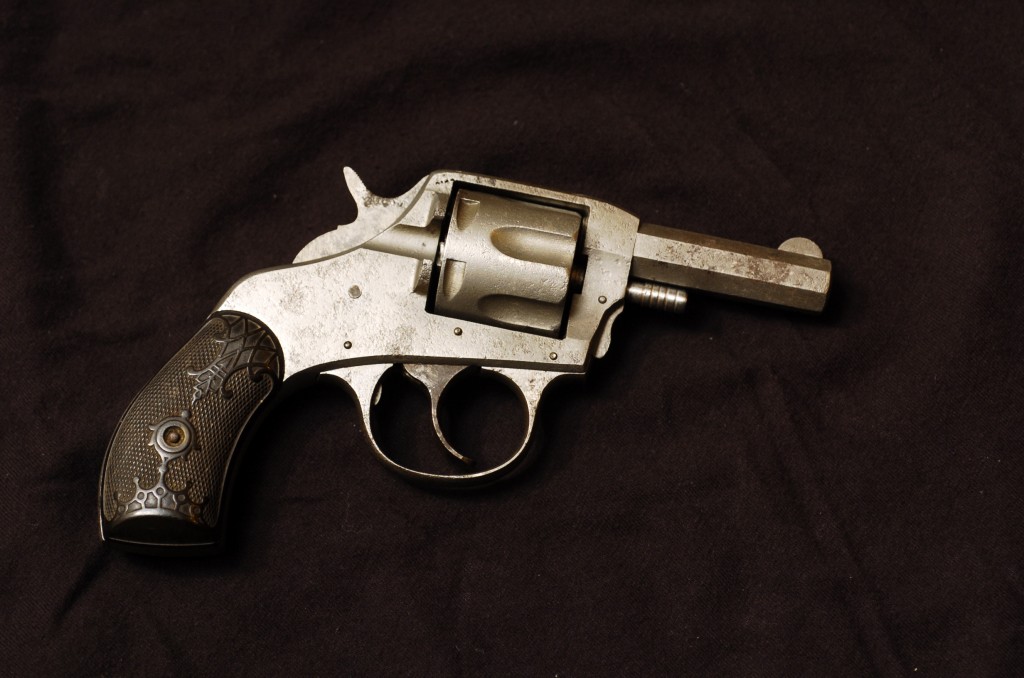
I haven’t shot this one, but I own a .22 caliber version that I have shot. I can’t say much about the accuracy, but as a pocket pistol, I suppose one can’t have expectations that are too high. Rather than invent some standard of accuracy to make it sound better than it is, let’s be honest, it’s good enough to gut shoot someone at across the room distances, but I wouldn’t count on it down a long hallway.
Written on December 29, 2013
By Tony
in Handguns, Revolvers
The New England Firearms company bought out the remaining inventory from Harrington And Richardson in 1986 or 1987 after H&R went bankrupt. They brought out the R73 and R73 ultra shortly thereafter. The R73 is a basic model based on the 5 shot swing out cylinder frame of the old H&R 504. The R73 had fixed sights, and the Ultra version had adjustable sights.
My version has a 6″ heavy barrel and has been pretty solidly accurate. The revolver isn’t any stringer than the H&R guns of similar design, and as such loads need to be kept within book specs for the .32 H&R magnum.

Much like the H&R’s the NEF revolvers are usually a good value, and for someone looking to break into the .32 revolvers, it would be hard to beat.
Written on December 28, 2013
By Tony
in Handguns, Revolvers
The .32 H&R magnum cartridge was introduced in 1984 with the H&R models 504 532 and 586. All 5 shot revolvers, the model 504 has a swing out cylinder and adjustable sights. My version has a 3″ barrel.
The little 504 is accurate enough, but I only shoot .32 S&W long loads in it to prevent unnecessary wear and tear.

The little H&R revolvers are generally a pretty good value, and will certainly do the trick. See the next chapter for info about the NEF version of the gun.
Written on December 27, 2013
By Tony
in Revolvers
When I was growing up, my father only ever owned one gun. It was given yo him by my grandfather when my parents were newlyweds and living in a less than ideal part of town. When my Dad passed a few years ago, I inherited the little revolver.
When I was a teenager, the little .32 S&W revolver was the first gun that I ever reloaded for. The cartridge is the .32 S&W cartridge, and not the .32 S&W long. The cartridge was one of the early centerfire cartridges, and was of course originally designed for black powder. Using roughly 8-10 grains of BP pushing an 85 grain bullet to about 650 FPS.
The revolver’s design dates back to the 1880’s when almost every gun maker, tool maker or manufacturing plant was making small pocket revolvers. The S&W design starts a little earlier than that, but the top break double action was essentially unchanged for nearly half a century when it went out of production in the late 1930’s. My Dad’s revolver came from the later era, an was most likely one of the last few thousand of the guns made.
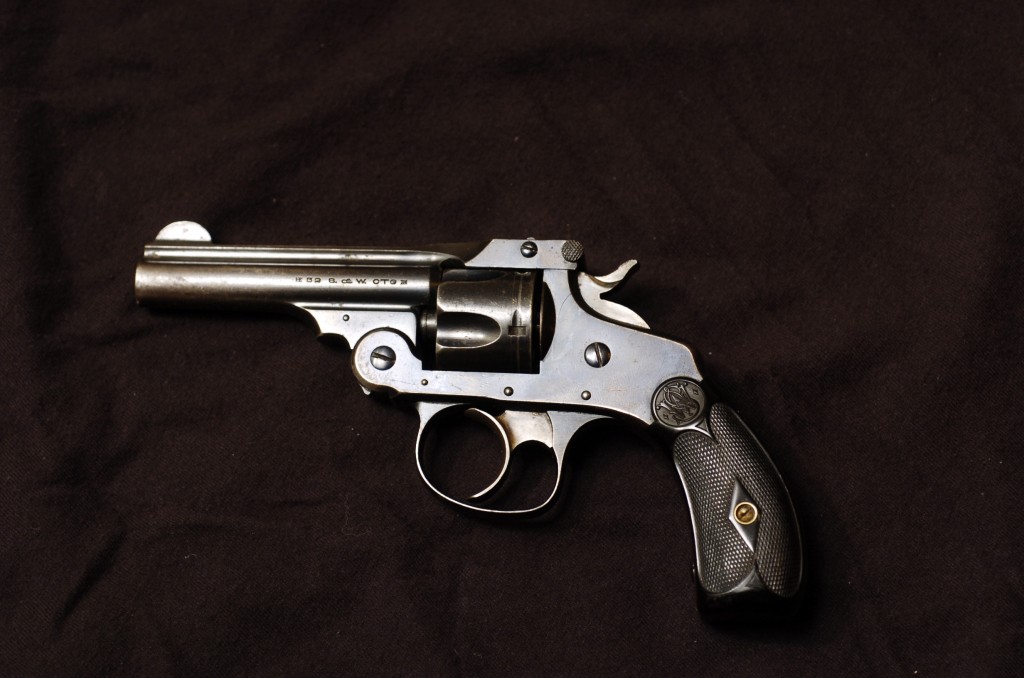
I rarely shoot the old revolver, but when I do, I reminisce about Dad.
I can’t say that I would choose the gun as a first line of self defense, between the rather anemic loads and crude sights, it’s certainly not ideal, but it would be better than a pocket knife!
Written on December 23, 2013
By Tony
in NFA, Repeaters, Rifles
About a year and a half ago, I bought my first bumpfire stock. It was around the same time that I bought my first machine gun. Of course, buying them at the same time meant that I had the bumpfire stock for almost a year before having my machine gun.
The bump fire stock I chose was the Fostech AA2 springless for the Ruger 10/22. It’s the updated version of the original Akins Accelerator stock. The original stock was approved for sale by the ATF, and then shortly thereafter reclassified as contraband. A number of folks lost their shirts and their cool on that deal. Several years later, Bill Akins made an arrangement with Judd Foster of Fostech, and the new and slightly less cool AA2 became available.
With the original AA, you simply pulled the trigger, and a spring mechanism would bump the trigger back and forth against your stationary trigger finger (this is why the ATF later changed their ruling). With the new version, your trigger finger remains stationary, as with the original, but instead of a spring moving the rifle forward and back, your off hand does by using the vertical fore grip.
At this point I have several of the AA2 stocks, but today I’m talking about one of the first ones I bought. Being young and impetuous, I decided that a .22 sounding like a machine gun might not draw enough attention on it’s own, so I had a local company hydrodip the stock with a flame pattern. The result is one of the visually louder guns that I’ve seen, and what is by far the most visually loud gun I have ever owned, and am ever likely to.

Over the course of the first year that I was messing with the AA2 stocks, I made several modifications that have added to the reliability and enjoyment. The first thing that I found to be important were the magazines. I only have 2 types of magazines that I would recommend for the AA2 guns; Ruger factory mags (BX1 or BX25) and Butler Creek “steel lips” magazines. Tactical inc TI25 magazines work as well, but are quite expensive in comparison and require tuning to make run properly. The HC3R magazines are alright, but don’t like the magazine quick loaders.
Another tweak that really helped with the guns reliability was to remove as much weight as possible. On the photo above the gun is wearing a Tactical Solutions X-ring barrel. The X-ring barrel is an aluminum outer shell with a steel sleeve in the middle that is the actual barrel. The construction provides heat dissipation and light weight. It weighs nearly a pound less than the factory barrel does! I’m also using a custom chamber reamer to chamber the barrels for any AA2 guns. A custom reamer isn’t needed though, just get a ‘sporting’ chamber reamer. The reason I use the reamer is to loosen the chamber slightly to improve extraction and feeding. A match chamber is great when trying to make the smallest group possible, but when attempting to shred pumpkins or knock over a row of steel plates, a loose chamber that causes fewer stoppages is much better.
The Kidd trigger assembly that comes as part of the Fostech kit is really an amazing piece of engineering. The trigger is light, but consistent, with the first stage providing a good tactile sensation to ensure you know you’re about to fire the gun.
If you listen close in the video, you can clearly hear the difference in rate of fire between the high velocity CCI minimags and the less powerful CCI standard velocity ammo.





















